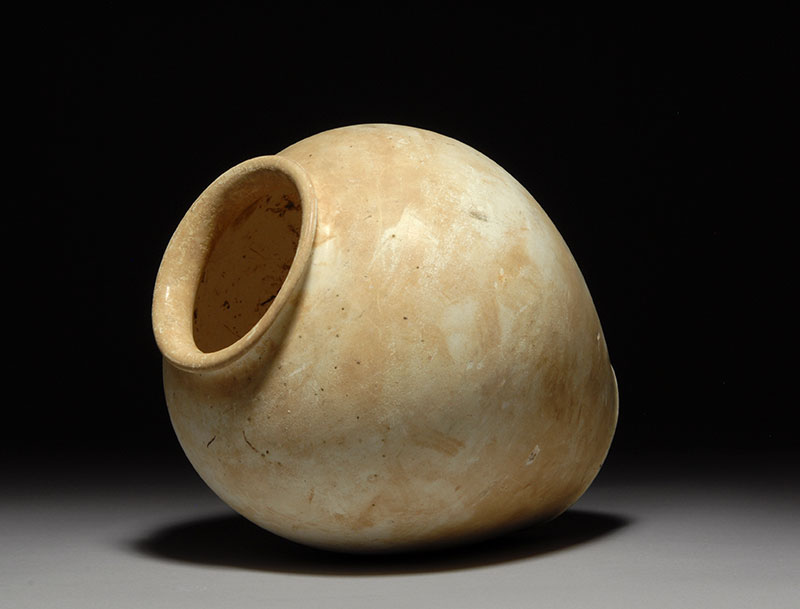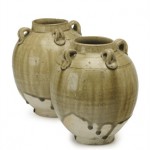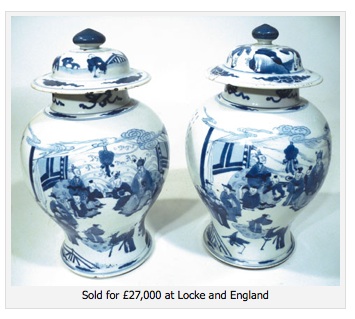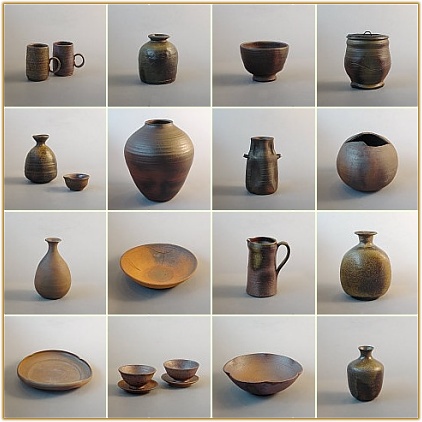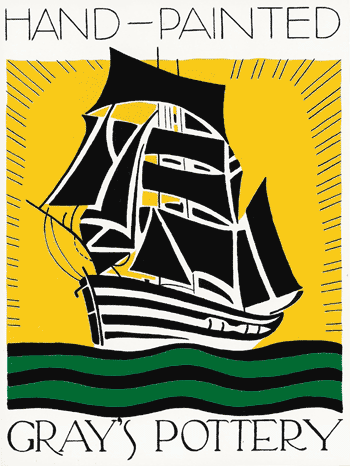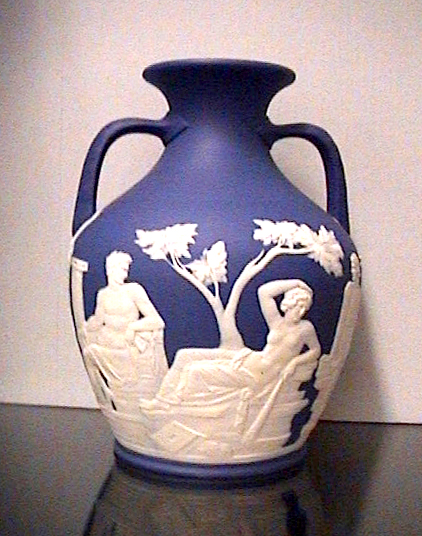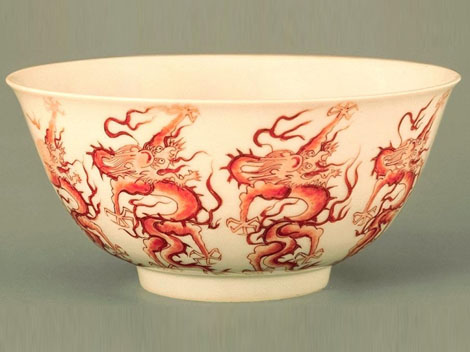Most Types of early Chinese pottery are available to the collector. Condition and quality are more important than sheer age. The most collectable pieces tend to be figures.
Until the end of the Song dynasty in 1280, generally Chinese ceramics were either stoneware or earthenware. The Han Dynasty (206 BC -220 AD) is known for it’s red earthenware’s. As with many ancient civilisations, pottery objects were placed in tombs for the dead to take to the afterlife.
The Tang dynasty (618-906) became the golden age of lead glazed earthenware, tinted green, blue or amber by adding copper, cobalt or iron pigments. Tang tomb figures have often been faked. In fact it quite easy to buy copies of the Tang horse in stores today, purely for decorative purposes.
During the Song dynasty fine stoneware was produced including the famous Ding wares of North China, noted for their rich ivory glaze with the moulded and incised decoration. Also from the North came Jun stoneware’s, which had thick blue glazes. The Celadon stoneware’s produced with greyish or olive green glazes were first made in the Song dynasty. Pieces of this period are extremely rare.
Tang(Seventh and Eighth Centuries A.D.)
The Sancai three-colour porcelain style of the Tang dynasty prevailed during the Seventh and Eighth Centuries A.D., from the time of Emperor Tang Gaozong(c.650 A.D.)to the beginning of the reign of Tang Xuanzong(c.731A.D.). Its principle origins are in Chang’an , Shaanxi Province, and in Loyang, Henan Province. Characterized by its lifelike forms, abundant subject matter and brilliant colours, it combined ceramic techniques with sculptural art and formed a valuable wellspring of Chinese ceramic technology.
The Sancai wares did not attract much interest from earlier collectors as they were virtually all burial objects. The Sancai or three-color technique consisted of using low-temperature glazing and white clay in roughcasting ; the work was finished through firing at a temperature of approximately 800℃. The glaze colouring and the moulding techniques of the Sancai style demonstrated superior skills and faithfully reflected attitudes towards life during the Tang period. It was during this golden age of the Tang period that the flamboyant, romantic colours of Sancai ware were most salient. A large number of three-colour porcelain wares have been excavated from Tang tombs; their principal value are as cultural artefacts created in a large variety of forms and shapes and replete with artistic life, so that the value of the ceramic art of the time is revealed more in terms of creativity than of practical use.
The fondness for horses during the Tang period can be seen in the frequency in which horses appear in the poetry and paintings of the time. The paintings are particularly exquisite and the folding technique used in creating the Sancai or three-colour horse shapes not only accurately replicated real-life figures through figure studies, but also yielded forms that were lifelike and vibrant. The Sancai horses were formed by molding and adding on white clay. Each position and each ornament was hand-moulded and pasted onto the body; in the course of the firing the molten glaze flowed downward so that the thickness of the glaze coating and lightness of the glaze colour were uneven, the top part of the figure being lighter in colour and the lower part darker. This successful union of glaze colouring and sculpture brought enhanced benefits to both arts and has formed the basis of porcelain manufacture through the ages.
Song(960A.D.-1271A.D.)
The foundations of porcelain manufacture laid down during the Tang era and extant at the beginning of the Song era, coupled with the demand by the Song Court for fine arts and culture, generated a new level of activity in porcelain production. For a period of time individual kilns became successively well-known; among these kilns were five of major renown most favoured by the Song Court of the time: the Ding Kiln, the Guan Kiln ,the Ru Kiln, the Ge Kiln and the Jun Kiln. Ceramic art during the Song era took the form of solemn, dignified shaping and refined glazed colouring, and the serene style of the single-colour glazes was perfected. A legacy of the Song Dynasty Ge Kiln is a type of ware with an elegant crackle consisting of black and brown lines.
On the glaze coating the spacing between the lines assumes a rhythmic appearance and there is a feeling of structure made up of primary and secondary lines. The lines and fragmented surfaces form an interesting pattern of black and yellow and called “Jin Si Tie Xian”, or golden threads and iron strands. These came to be counted among the most renowned of the Song kiln products: with their pristine beauty and high quality of the time, they were objects of appreciation and delight for many early collectors of porcelain and thus models of imitation throughout the ages. Identification of Ge Kiln porcelain has therefore been characterized as requiring close discrimination.
Yuan(1271A.D.-1368A.D.)
With the Mongol Kublai Khan’s termination of the Song dynasty and his establishment of the Yuan dynasty that lasted nearly a century, the native(Han)Chinese, now under domination by a foreign people, experienced a new life and culture never previously encountered. Generally barred from political careers, the Han Chinese adopted an unconcerned attitude towards affairs of state and turned towards commerce and cultural development. By way of these two avenues, culture during the Yuan period, while outwardly appearing to decline, took the form of a burgeoning, vibrant, latent force which was to lay the foundations for the ceramic arts of the later Ming and Qing(Ch’ing)periods.
During the Yuan period, porcelain production flourished exclusively in Jingdezhen(Ching Te Chen, which had become the centre of the porcelain industry for the entire country. The most representative examples of Yuan-period porcelain from Jingdezhen include the blue-and-white(Qinghua)and red-in-the-glaze, or under glaze red (You lihung)styles, which, with their use of cobalt blue and copper red in coloured under glaze paintings, replaced the serene style of the Song kilns which had been characterized by monochrome glazes.
Ming(1368A.D.-1644A.D.)
The driving out of the Mongols by Zhu Yuanzhang, his establishment of the Ming Dynasty, and the restoration of the country to the Han Chinese released the latent cultural energy that was stored up during the Yuan dynasty, Culture took on a new, thriving look, people became prosperous, and the economy expanded and in turn stimulated demand for the arts. The serene style of Sung era and the creative fervour of the Yuan era evolved into the blue and white and You li hung ceramic styles of the Ming era, and wares appeared with profusely painted artwork. The shapes and artistic ornamentation show Western Asian and Persian influences, and styles took Persian and other non-Chinese overtones.
Blue and white porcelain was immensely popular and formed the mainstream of Ming ceramics. As ceramic kilns flourished, the material quality of the porcelain wares achieved a high level of excellence. Jingdezhen in Jiangxi province became the focal point of porcelain manufacture throughout the country. We may note that the Dehua kilns located in southern Fujian province also produced a high amount of white porcelain.
Some of the products manufactured at the kilns in Jingdezhen were shipped abroad: these were termed waixiaoci(porcelain for sale abroad). The raw materials used in the most representative blue and white Ming wares may generally be classed into three types of colouring materials: (1) What was termed “Sunipo blue”(”Sumali blue”)was a coloring material used in early Ming blue and white porcelain. It is on record that “Sumali blue was regarded as decoration and fresh red(xian hong)was regarded as precious.”
Porcelain wares with Sumali blue artwork have a rich dark blue with black and silver spangles. Chemical analysis shows the material to have a low content of manganese. It was produced in Persia and was distinctly different from the blue material produced in China. (2) Potang blue, termed “pingdeng blue”, appeared during the mid-Ming period. It was one of the raw materials used in the mid-Ming blue and white porcelain from Jingdezhen. This type of colouring material was called “natively produced blue”. Potang blue was a refined , quiet colour, quite different from the rich darkness of the Sumali blue of the early Ming period. (3) Mohammedan(Hui)blue, used during the late Ming period, was originally a blue material imported from abroad and was used in Jingdezhen.
An inspection of the wares handed down to us shows that it was in continuous use during the late Ming period. The material was of a uniform colour consisting of a blue with a hint of purple, different in hue from the Sumali and Potang blues. The Dehua blue and white porcelain of the Ming era was produced in the Yanhai area of Fujian province, from ancient times one of the major producing areas of porcelain for sale abroad. The southern region was most prolific in its use of subject matter. In addition to the blue and white porcelain, numerous Kuan Yin, Bodhidharma and other fihurines of the Song, Yuan and Ming periods were produced in a white porcelain in which the glaze blended with the body of the work to form an unbroken entity(blanc de Chine.
The porcelain resembled white jade and was praised as being “ivory white, creamy white, the velvety white of a swan”. During the Qing dynasty the area produced, in addition to white porcelain ware, numerous blue-and-white and painted wares, and, throughout the Yuan, Ming and Qing eras Dehua porcelain wares were exported in large quantities.
Ching(1644A.D.-1911A.D)
The Kangxi, Yongzheng and Qianlong Courts of the early Qing period placed special care in appointing ceramics overseers for the imperial kilns in Jingdezhen, with the result that ceramics techniques advanced more quickly. The practices of the Yuan and Ming periods were taken up and continually refined, efforts were consolidated, and the result was invariably highly productive. It was in this way that the porcelain industry in China reached its peak. Porcelain production during the Qing period was of two major types: innovative and imitative. Traditional forms from all ages reappeared at this time.
One innovative type of ware was painted porcelain of the enamelware type in Chinese wares. Coming from the first three reigns of the Qing period, it drew the greatest interest from collectors. Famille rose and enamelling(yangcai)are most characteristic of Qing porcelain, and particularly at the end of the Qianlong reign(time of the Emperor’s father)and early stage of the Jiaqing reign, older imperial porcelain makers produced excellent work. Such work best revealed the refinement in the techniques of porcelain manufacture.
The Chinese snuff bottles which attracted early Western collectors were a minor element in the collection from collectors in China and have developed strong potential as collectors’ items. Snuff bottles have had only three hundred years of history, from the beginning of the Qing era to the present day. Determination of their period of time is easy and there is no problem of contention over whether an article is genuine or spurious. These are small, delightful, delicately crafted wares, formerly appreciated only by Western art collectors but recently drawing progressively more interest from Chinese collectors, to the point that snuff-bottle collecting has now become a major trend.
Summary
Ceramics is one of the plastic arts using firing techniques in the formation of artwork. We find pottery in unrefined, plain styles already in use during the Neolithic Age. True porcelain wares appeared during the Eastern Han period, and the techniques and artistry of ceramic production achieved a high degree of maturity during the Tang ear.
The ceramics industry flourished during the Song period and individual kilns distinguished themselves. Ceramic arts during the Ming and Qing dynasties were characterized by improvement of the techniques over earlier times, ranging from roughcasting, decorating and glazing to firing. Chinese ceramics still flourishes and has yielded high-quality, artistic work, its shapes and glazing patterns attaining high artistic standards and gaining worldwide recognition. A study of the ceramics art collections reveals an ongoing evolutionary trend in the culture, economy and lifestyles of our ancestors through the ages.

